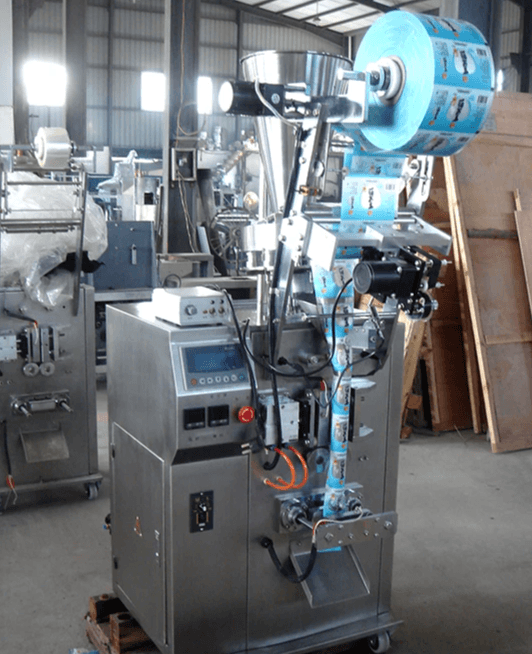Powder sachet packaging machines are essential in the pharmaceutical, food, cosmetics, and chemical industries. They automatically fill fine powders into sachets and seal them through a precise coordination of systems: powder feeding, weighing, sachet forming, filling, sealing, and cutting. These machines are commonly used for products like protein powder, instant coffee, and medicinal powder.
However, during long-term operation, issues may occur—causing production interruptions or unstable product quality. Fortunately, most of these failures are related to three core factors: powder flow behavior, heat-sealing temperature control, and film alignment accuracy. By understanding the root causes and implementing regular maintenance, you can prevent downtime and improve production efficiency.

Common Problems and Solutions
1. Inconsistent Filling Volume
Main Causes:
- Powder Bridging: The most common cause. Poor hopper design, rough inner surfaces, or poor powder flowability can cause a stable arch above the outlet—resulting in inconsistent powder flow.
- Powder Density Variations: Changes in particle size, distribution, or moisture content affect bulk density. Since most machines measure by volume, weight variation occurs.
- Metering System Errors: For auger fillers, worn auger screws cause inaccurate filling; for net weight fillers, sensor drift, vibration, or air turbulence affects weighing accuracy.
Solutions:
- Eliminate Bridging: Regularly clean the hopper to maintain a smooth surface. Install agitators for powders prone to arching.
- Improve Powder Flowability: Ensure powder is dry and maintain workshop humidity at 40–60%. Use forced-feeding fillers for powders with poor flowability.
- Precision Calibration: Check auger screw clearance and replace if worn. For weight fillers, calibrate using standard weights before each shift or product change.
2. Powder Leakage and Dust Accumulation
Main Causes: Powder may leak through unsealed edges or tiny gaps around the filling nozzle. Low sealing temperature or uneven pressure can cause incomplete sealing.
Solutions: Adjust sealing temperature in increments of 5°C and observe results. Ensure seals are strong, flat, and consistent. Keep sealing jaws clean—powder stuck on them can prevent proper sealing.
3. Film Wrinkling or Misalignment
Main Causes: Improper film feeding results in wrinkles, uneven seals, or curved sachets. Causes include worn film rollers or incorrect tension.
Solutions: Ensure the film roll is correctly centered and aligned. Adjust tension to “tight but not overstretched.” Clean guide rollers and photoelectric sensors regularly to maintain film tracking accuracy.
4. Sealing Defects
Main Causes:
- Uneven Heating: Damaged heating elements or inaccurate thermocouples cause inconsistent temperature between sealing bars.
- Contamination on Sealing Surface: Powder or oil on sealing jaws blocks heat transfer.
- Film Parameter Mismatch: Different materials (PET/PE, CPP, aluminum foil) require specific temperature, pressure, and sealing time.
Solutions: Clean sealing jaws regularly, ensure both sealing bars reach the same temperature, and follow the supplier’s recommended range for multilayer films.
5. Static Electricity Issues
Main Causes: In low-humidity environments (<40%), friction between powder and machine generates static electricity, causing powder to cling to machine surfaces or interfere with accurate filling.
Solutions: Maintain humidity between 40–60%, ensure proper grounding, and install anti-static ionizing blowers in key areas such as the hopper or sealing zone.
Best Practices & Preventive Maintenance
Daily Maintenance: Clean powder residue from hopper and sealing areas, wipe sealing jaws, sensors, cutters, and fill out inspection records.
Weekly Maintenance: Inspect sealing belts, cutters, and film rollers for wear; lubricate moving parts as specified.
Monthly Maintenance: Perform deep calibration on weighing systems; check transmission components (belts, chains) for wear or looseness.
Environmental Stability: Maintain a controlled workshop environment. Powder flowability is highly sensitive to humidity and temperature. A stable environment ensures high sealing quality and filling accuracy.
Frequently Asked Questions (FAQ)
1. How often should a powder packaging machine be cleaned?
After every shift. For powders that are sticky, hygroscopic, or corrosive, clean every 4–6 hours or between product batches.
2. How to pack highly sticky powders (e.g., herbal powder, fruit powder)?
Use a hopper with agitators and Teflon-coated surfaces, maintain strict humidity control, and use anti-static, high-slip composite films.
3. What is the ideal humidity for powder packaging?
40–60%. Below 40% causes static; above 60% leads to clumping.
4. How to prevent sachet misalignment?
- Clean and secure photoelectric sensors.
- Adjust sensor sensitivity and delay settings.
- Ensure smooth film feeding across all rollers.
- Check the film correction mechanism for looseness or delayed response.
5. Are there powders not suitable for sachet packaging machines?
Extremely fine, sticky, or oily powders may require auger fillers or specialized feeding systems instead of standard sachet packaging machines.
Conclusion
With proper cleaning, calibration, and humidity control, the most common issues—such as inconsistent filling, poor sealing, and film misalignment—can be effectively avoided. Operators should follow daily checklists to keep the machine in optimal condition.
If your production line faces unique challenges or you want a customized solution for your product, LTPM CHINA is here to help. We provide high-performance automatic sachet packaging machines, along with a 5-year warranty, on-site process tuning, and lifetime technical support.
Contact us today for a free consultation and a tailor-made production line upgrade plan!